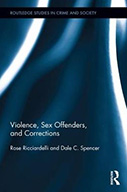Violence, Sex Offenders, And Corrections

Authors: Rose Ricciardelli; Dale C. Spencer
Publisher: London: Routledge, 2017. 134p.
Reviewer: Richard Tewksbury | May 2018
In Violence, Sex Offenders, and Corrections authors Rose Ricciardelli and Dale C. Spencer provide readers with a view into the experiences of incarcerated sex offenders and how they encounter, manage, avoid and sometimes inadvertently invite violence. The book is based on a study of Canadian federal inmates and focuses on how social constructions of sex offenders and the values of other inmates intersect to create a bottom of the barrel population that is seen as appropriate targets for violence.
Ricciardelli and Spencer’s argument is built on the idea that sex offenders are so despised and feared that they are constructed as a chimeric character. In essence, “the sex offender is viewed as a terrible creature that must be eradicated through containment and violence” (p. 3). As such, all about the sex offender is considered devalued and despised. With such a stigma attached, chimeric sex offenders are relegated to a place of persistent vulnerability. This vulnerability, in turn, establishes the foundation of the social identity of sex offender inmates, and creates a social environment in which sex offenders are always aware of their status and always in fear of attack.
Violence for incarcerated sex offenders comes in three basic forms – violence from other inmates, violence from staff and violence from the cultural knowledge that persons like them are despised and sought out for violence. Most common is violence from other inmates. When a sex offender’s offenses are known (or suspected) by other inmates, they are ostracized and used as symbolic victims for others to establish their own superior status. The stigma is so great for sex offenders that it is necessary for other inmates to act against them in order to preserve their own status and safety.
Violence from institutional staff persons may include direct violence, but more often occurs in the form of intimidation and manipulation. Staff who know of a sex offender’s offenses use the information and the threat of disclosing it to the institution’s population as a way to control and further marginalize sex offenders. Not uncommonly staff will share information with other inmates as a way to sanction a misbehaving sex offender or to “teach a lesson” to sex offenders.
Violence from the cultural knowledge about sex offenders is experienced in the form of an omnipresent set of values and norms that denigrate sex offenders. Inmates see other sex offenders be attacked and ostracized; they experience other inmates attempting to decipher their offenses (so as to know if they are chimeric or not) and everyday language, actions and expressions of resentment that tell the sex offender he is vulnerable, despised and likely to be victimized.
Ricciardelli and Spencer go beyond just telling readers that there is violence and the forms in which it is present. So too do they explore through interviews with sex offenders how attempts at identity management are employed, and how information control is central to the survival of incarcerated sex offenders. Additionally, the means that non-sex offenders use to attempt to determine the offenses (and therefore status) of sex offenders is also explored.
The strength of the book is in the fact that there are qualitative data behind the theory presented, and the sex offender inmates’ voices are heard and used to explain the issues and perspectives. In fact, this strength could be even stronger and more powerful if the data were exploited more, and the voices of this highly vulnerable population were more front and center. The book is informative, and for readers unfamiliar with the dynamics of incarceration and social stigmatization of sex offenders this will be a revealing and troubling read. But, while informative for those unfamiliar with correctional cultures and sex offenders, there is not much new here. For some readers this will be a disappointment. However, the fact that we have long known the basics of what Ricciardelli and Spencer report here is additional evidence for the argument that sex offenders simply do occupy a very different status and place in correctional environments. The argument is clear here that sex offenders are different because “we” make them that way in our constructions and responses to them. This is the major contribution of this book, and this is the contribution for which Ricciardelli and Spencer should be cited.
Violence, Sex Offenders, and Corrections is a valuable book and one that while seemingly simply telling us yet again what we know about sex offenders and their place in society, also looks beyond the surface level and explores the how and why of such strong stigmatization practices. The readership target here is academics and those seeking a theoretically inspired understanding of corrections, violence and sex offenders. Readers who come to the book seeking practical uses and guidelines for how to manage sex offenders in a correctional setting will be disappointed. This is not the focus of the text, and as such, is not present. Rather, the text takes an approach of documenting what occurs for incarcerated sex offenders, and that is all.
Richards Tewksbury, Arizona State University


